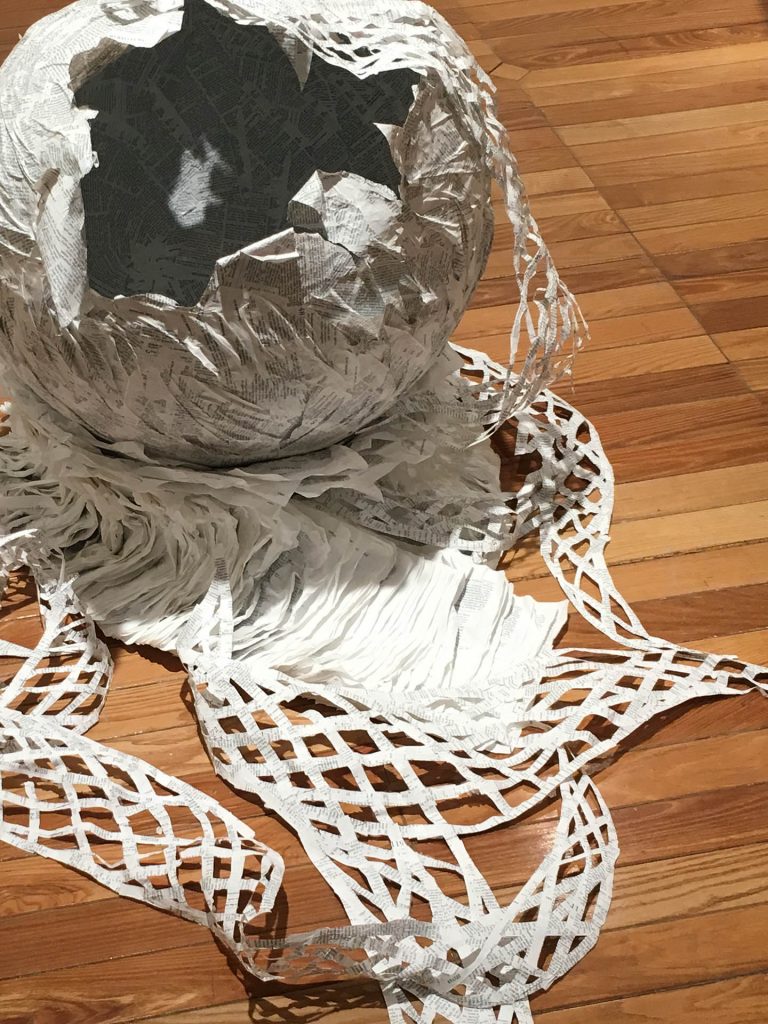Generally, I do not approach images to make a specific statement. My experience has been that when I work that way, the art is horrible! Sometimes, when I am not looking for it, an image approaches me. These pieces are a bit like being hit over the head with a two by four. There is a painting at Wesley Seminary by Alexi Rappaport called Angel and Prophet. In the painting a man is being force fed a scroll by a sword wielding angel. I’ve always appreciated the painting as I know how it feels to have a work insist on being made. The work that I now call the St. Louis Bible was one of those.
Created after the Special Session of the General Conference of the United Methodist Church (UMC) in February 2019, this piece is a response to the hurt, anger, and grief surrounding me as my UMC friends, colleagues, and students grappled with the aftermath. For those of you not in a position to be following the finer point of UMC polity, here is a brief overview of the situation.
The United Methodist Church is the largest mainline Protestant denomination in the United States. It also has churches in 40 other countries. The international body meets every four years at a General Conference. While other denominational bodies have resolved their issues with human sexuality, particularly as it relates to ordination and marriage (some for, others against), the UMC has not. The last several cycles of General Conferences have been bogged down with this issue, each time pushing the conflict to the next conference. At the 2016 General Conference, in response to a near-split within the church relating in part to the sexuality issue, “a commission on a way forward” was created in hopes of maintaining denominational unity. Part of this process was to call a Special Session of the General Conference in 2019 in St Louis. At the Special Session, three plans to move forward were put to a vote. The plan that passed upheld language that denied full inclusion of LGBTQ persons in the church and added additional punitive language to sanction disobedient churches and clergy. This additional language is problematic beyond the LGBTQ issue as it sets a precedent giving the General Conference more power over the local conferences, which historically have had tremendous autonomy. If you want the full picture you can watch this. The dispute continues, leaving the UMC turmoil as the 2020 General Conference approaches, not just over human sexuality, but the deeper underlying issue of biblical interpretation over which a denominational break-up may be inevitable.
As a Presbyterian who spent the last decade working at a UMC seminary, I have had a ringside seat as this situation unfolded. I have watched as some of our brightest and best students (who happen to be LGBTQ) struggle with the decision to stay with the denomination or change to one where they can be who they truly are. After the Special Session, the anguish around me was incredibly intense. Not only from our LGBTQ community, but also from lifelong UMC members and long serving pastors who care deeply about inclusivity, who found themselves questioning whether they could stay with the church. At that time, I was working on paintings for a show in January and had taken a break to experiment with an idea for a deconstructed Bible (more on that later) when this piece insisted on being made in response.
The St. Louis Bible is aggressively sewn shut manifesting the impulse some are following to protect and control the Biblical content and the church. It is ugly. It is a reaction out of fear. In the days and weeks following the events in St. Louis, I was hearing a line from the hymn “Let all the world in every corner sing.” (full text below) “No door can keep them out” reverberated in my mind. The doors on the front of the Bible burst outward not only in affirmation of LGBTQ folk as rightfully part of the church, but also as a reminder that no human action can contain the spirit.
As I have lived with this object for a while, I have begun to think about its broader implications. It would be easy to take this affirmation and turn it into a bludgeon. I find myself asking whether I have ever attempted to close something off in response to what I perceive as a threat. The answer of course is yes. It is something I must remind others to keep in mind as I release this work into the world.
More images of this Bible including process shots can be found here:
http://amyegraystudio.com/objects/the-st-louis-bible-creation
Let all the world in every corner sing,
My God and King!
The heavens are not too high,
His praise may thither fly:
The earth is not too low,
His praises there may grow.
Let all the world in every corner sing,
My God and King!
The church with Psalms must shout.
No door can keep them out:
But above all, the heart
Must bear the longest part.
Let all the world in every corner sing,
My God and King!
Music: Ralph Vaughan Williams (1872-1958)
Text: George Herbert (1593-1633)
